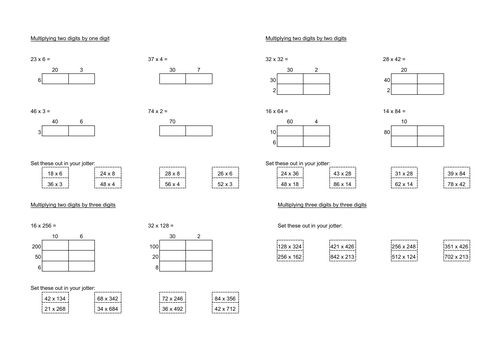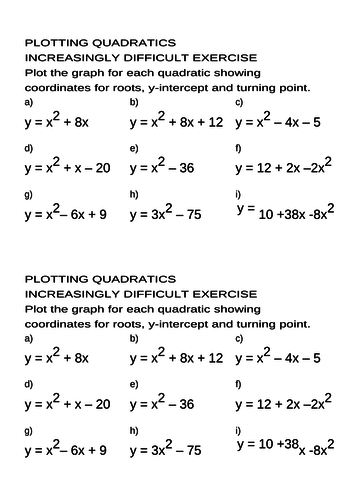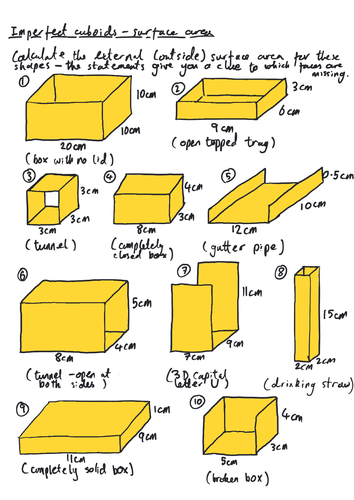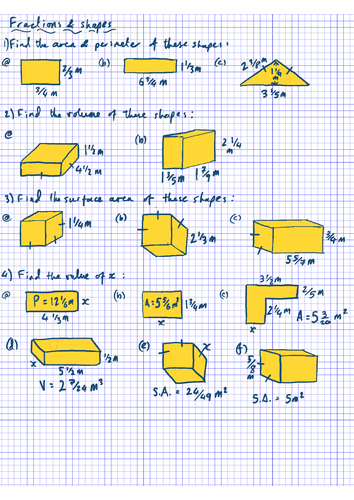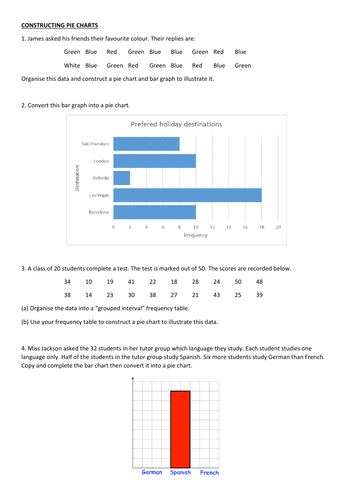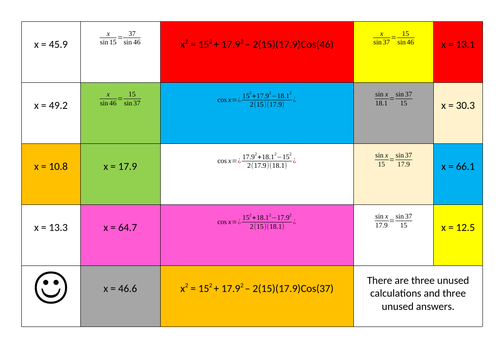
53Uploads
31k+Views
23k+Downloads
All resources

Straight line equation open questions
Pupils have to write appropriate equations for the lines on the axes.
Good for reinforcing what the terms gradient and y-intercept actually mean.
In some cases there are an infinite number of right answers and even more wrong answers!

Multiplication with grids worksheet
Grid multiplication of:
2-by-1 digits
2-by-2 digits
2-by-3 digits
3-by-3 digits
Each section offers support in the form of predrawn grids. Level of support lessens with each grid. Pairs of questions have the same answer as a way for pupils to self check their work. These answers also offer the opportunity for discussing the effect of “double one, half the other”.

Plotting quadratic graphs - increasingly difficult questions
Answers included if you follow the link included on the last page to the Desmos graphing website.
Inspired by Dave Taylor’s excellent set of resources on his Increasinly Difficult Questions website.

Cuboid surface area - incomplete and compound shapes
Some quick, hand drawn questions finding the surface area of “imperfect” cuboids (with holes in them or missing faces) and compound shapes. Numbers have been kept deliberately small to avoid pupils getting bogged down in number work, allowing them to focus on the actual shapes.

Dienes Blocks and Percentages
A set of tasks using Dienes blocks to make connections with percentages.
I used it as a handout for the pupils. On reflection it might work better with the “information” bits being used as teacher notes then pupils trying the tasks in their jotters. The “information” could be used as teacher led examples on the whiteboard using the mathbot website while the pupils working through the tasks with the manipulatives and whiteboards to get the answers.
I worried too much about pupils recording their answers and methods which got in the way of them actually using the manipulatives. I’d recommend just leaving the pupils to use the blocks to get their answers and build an understanding first and then firm up the formal layout in later lessons.
I’ve included the resource as a PDF and a Word doc which you can edit as you see fit.

Mixed number and perimeter, area, and volume
Working with mixed number in the context if 2d and 3d shape. Some problems involve finding missing dimensions.
Hand drawn worksheet but some decent questions in it so who cares about looks?

Constructing pie charts (no frequency tables given!)
Some pie chart construction questions. All the angles should work out as whole numbers but the data has not been presented as a frequency table as it tends to be in all the worksheets I’ve found on-line. Pupils either have to construct a frequency table themselves or convert from a bar graph. Not exactly the most difficult but a bit of a change from how these are normally presented.
Some of these questions have been adapted from various tasks on the CorbettMaths website.
Uploaded as a pdf and editable Word doc.
Answers may be uploaded at a future date. Maybe.

Trigonometric Equations - matching cards task
Pupils have to rearrange trig equations to solve. This is done by matching up cards from each column. Some cards have been deliberately left blank. Some common errors have been considered and included (ie 3 - 5tanx = 0 may be incorrectly matched up to the card tan x = 5/3).
Pupils could complete task by cutting and sticking down matched cards or labeling/colour coding the matching cards without cutting up.
Task in pdf form. Answers included as is an editable word doc version.
Task made for a National 5 (Scottish SQA) class.
Fixed version uploaded: 26/11/21

Non right angled trigonometry matching task
Eight triangles to match up with the appropriate trig rule and answer. Triangles repeatedly use the same numbers to keep students on their toes. There are three extra sets of workings which pupils can create their own triangles for.
Worksheet and answers as pdf and editable word.

Less common units of distance
A collection of less common units of distance for pupils to order from largest to smallest.
Silly little task to fill in the end part of a lesson.
Answers and potential extension / research task included.

Finding multiples of 10% using grids
Nothing fancy. Find multiples of 10% by finding 10% first. Scaffolded around a diagram of 100% split into ten equal boxes of 10%. Pupils fill in the value of 10% and shade in the required amount.
PDF and editable Excel file included.

Thinking about averages and spread using towers
This task focuses on what the averages look like rather than how to calculate them. This could be done with piles of blocks/cubes if you wish (though some of the means work out with decimal values).
Inspired by the “mean average equal sharing” activity by Don Steward:
Resources uploaded:
PDF of resource
Editable Excel spreadsheet of resource
Don Sterward slides from above link


